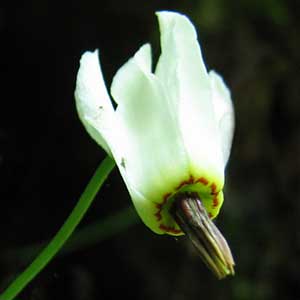Dodecatheon dentatum
Dodecatheon amethystinum
dentate shooting star, tooth American cowslip, white shooting star
jeweled shootingstar
not obvious at anthesis, or sometimes erect to slightly horizontal, slender;
roots white or reddish;
bulblets absent.
not obvious at anthesis;
roots white;
bulblets absent.
(3.5–)8–20(–30) × (1–)2.5–6(–7) cm;
petiole slightly winged;
blade ovate, base decurrent onto stem, abruptly tapering to petiole, margins subentire to sinuate or crenate, surfaces glabrous.
4–25 × 1–8 cm;
petiole often winged;
blade oblanceolate to oblong, base decurrent onto stem, often gradually tapering to petiole, margins entire, surfaces glabrous.
(1–)2–5(–11)-flowered;
bracts lanceolate, 1.5–5(–8) mm, glabrous.
1–10(–24)-flowered;
bracts narrowly or broadly lanceolate, 2–10 mm, glabrous.
0.8–5 cm, glabrous.
1–5 cm, glandular at proximal 1 or 2 nodes, glabrous distally.
calyx light green, 4–6 mm, glabrous, tube 2–3.5 mm, lobes 5, 1.5–3(–4) mm;
corolla tube yellow with red, thin, wavy ring, lobes 5, white, 7–18(–20) mm;
filaments distinct, maroon to black, 0.1–0.5 mm;
anthers (4.5–)5–7.5 mm;
pollen sacs maroon to black, connective dark purple to maroon, smooth;
stigma not enlarged compared to style.
calyx light green to green, 3–8(–10) mm, glabrous, tube 3–5 mm, lobes 5, (1–)3–7 mm;
corolla tube usually maroon with maroon, thin, wavy ring, lobes 5, pink to purplish, rarely white, 8–20 mm;
filaments connate, tube maroon, 0.5–2(–2.5) × 2–3.5 mm;
anthers (3.5–)5–7.5(–8.5) mm;
pollen sacs reddish to maroon, rarely pale, connective maroon, smooth;
stigma not enlarged compared to style.
pale greenish to tannish, dark yellow apically, valvate, narrowly ovoid, (6–)8–11 × 3–5 mm, glabrous;
walls thin, pliable.
light brown to reddish brown or yellowish, valvate, cylindric-ovoid, 7–16 × 3–5 mm, glabrous;
walls thin, pliable.
without membrane along edges.
without membrane along edges.
= 44.
Dodecatheon dentatum
Dodecatheon amethystinum
Dodecatheon dentatum occurs mainly on the eastern slope of the Cascade Range from south-central British Columbia to central Washington, with disjunct populations near the Columbia River in southwestern Washington, the Columbia River Gorge, northeastern Oregon, and northern Idaho. In Idaho, this species occasionally forms hybrids with D. pulchellum var. pulchellum (Oberle 262, MO).
(Discussion copyrighted by Flora of North America; reprinted with permission.)
Dodecatheon amethystinum is found mainly on, and at the bases of, limestone cliffs in hardwood forests from southwestern Wisconsin and adjacent southeastern Minnesota to northeastern Iowa, western Illinois, and eastern Missouri. It is disjunct to the eastern Appalachian Mountains of southeastern Pennsylvania; reports from northern West Virginia are based on specimens of D. meadia. Vegetatively, D. amethystinum is allied to D. meadia although its thin-walled (rather than thick and firm) fruit is like that of D. pulchellum. The only truly distinguishing feature between it and D. meadia is the fully mature capsules (L. H. Klotz and C. Loeffler 2007). In D. amethystinum, length of the light to reddish brown or yellowish capsule often is more than three times the diameter. The length of the dark reddish brown capsule of D. meadia is less than three times the diameter. As noted by H. H. Iltis and W. M. Shaughnessy (1960), D. amethystinum tends to grow on moist cliff faces and bluffs; D. meadia tends to occur on drier sites in prairie settings and in deciduous woodlands. Dodecatheon meadia is sometimes found in moist areas, and even on cliff faces; these sites are still comparatively drier. According to A. F. Cholewa, some populations in southern Minnesota that she considers to be D. amethystinum have leaves that are relatively broad and tend not to taper gradually to the petiole. In that light, continued recognition of D. amethystinum at the species level becomes dubious.
(Discussion copyrighted by Flora of North America; reprinted with permission.)


